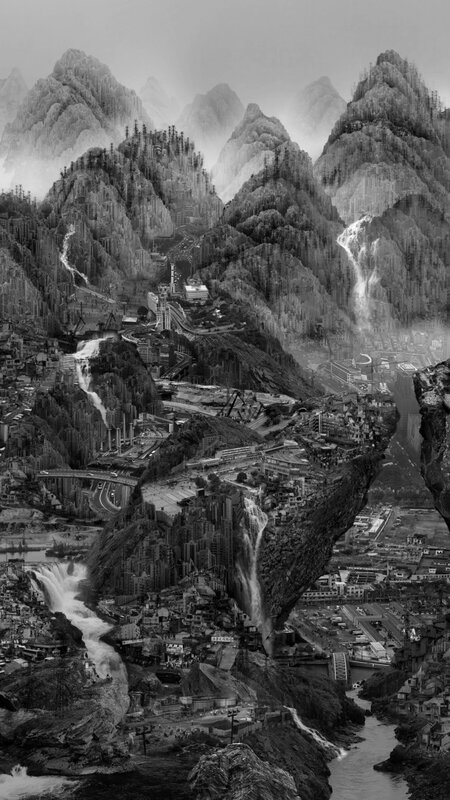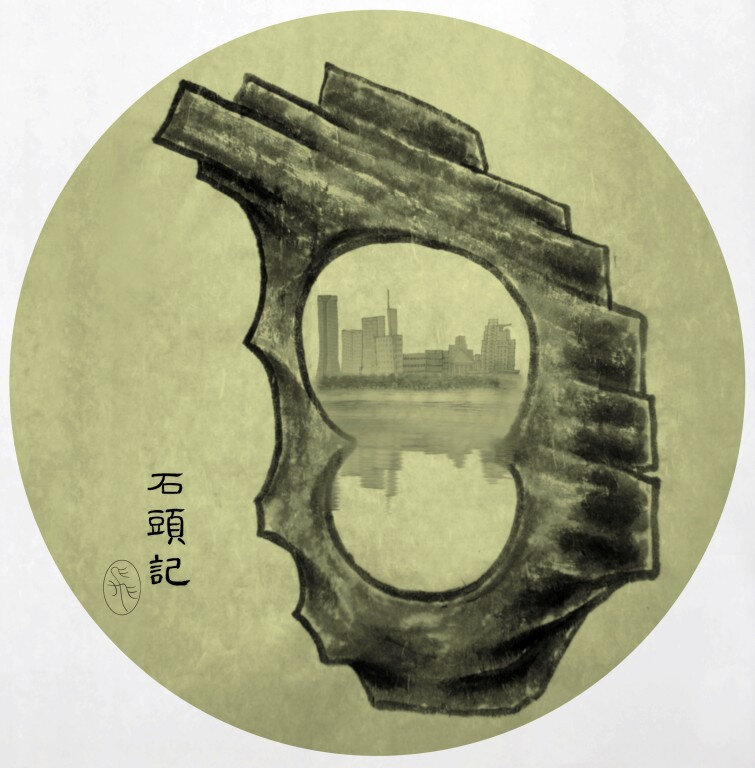Exhibition at Museum für Kunst und Gewerbe Hamburg engages Chinese ink traditions
Print the Landscape Public Art Project, Rubbing from wall tiles from the St. Pauli Elbtunnel, Hamburg, 2018, ink on paper, on loan from the Zhejiang Art Museum, Hangzhou, © Zhejiang Art Museum, Hangzhou.
HAMBURG.- As part of CHINA TIME Hamburg, the Museum für Kunst und Gewerbe Hamburg has invited artists to engage with Chinese ink traditions such as ink painting, book printing, and stone rubbing, as well as with MKG’s own East Asia Collection. As a result, the exhibition Inky Bytes. Traces of Ink in the Digital Era shows works by the Print the Landscape Public Art Project and the artists Shan Fan, Dagmar Rauwald, Liu Ding, Yang Yongliang and Zhou Fei, who illuminate various aspects of digitalization and urbanization, two key themes of this year’s CHINA TIME Hamburg (1–23 September 2018). Today’s digital media and technologies are putting traditional image-making techniques to the test, sparking an intense exploration of the traditional arts. More than half of the contemporary works presented were created exclusively for the show at MKG. They reflect the diversity of ways in which artists are treating the traditional use of ink. One of the central motifs is the city as landscape and habitat. The featured artists from China and Hamburg demonstrate very personal impressions of the city of Hamburg, for example, by doing stone rubbings with ink on paper of ceramic tiles in the Old Elbe Tunnel in St. Pauli or of flood markers, church walls, the “Stolpersteine” stumbling blocks that commemorate Nazi victims, and even manhole covers. The works on view also include installations, paintings, videos, furniture, robes, woodcuts, posters, hanging scrolls, and porcelain. In addition to presenting these artistic impressions, the exhibition also demonstrates based on over 150 exhibits the considerable impact MKG’s high-caliber collection of historical Chinese art, which once served as a set of models for use by artists and artisans, still has in Hamburg today and how it is now also unfolding a more global perspective. MKG regards itself as an interface linking various stakeholders of the city’s art scene while also connecting Hamburg and China. A catalogue in German and English will be published in early October to accompany the exhibition.
Print the Landscape Public Art Project (2017–2018): The Zhejiang Art Museum initiated the Print the Landscape Public Art Project with local artists in Hangzhou in 2017. In the project, the approximately 1,500-year-old stone rubbing technique is used to reproduce the surfaces of famous rocks, steles, and vegetation in the garden city of Hangzhou on West Lake. Under the direction of Zhang Xiaofeng (China Academy of Art, Hangzhou), the Print the Landscape Public Art Project came to Hamburg in July 2018 to undertake a similar endeavor. Chinese and local artists did stone rubbings together of wall tiles in the Old Elbe Tunnel in St. Pauli, flood marks in Övelgönne and trees on the Grosse Moorweide. Other stone rubbings remind us of the fate of Hamburg’s citizens under the Nazi dictatorship. The bomb-battered walls of the St. Nikolai Memorial are joined by rubbings of the “Stolpersteine” in the pedestrian zones of the Hanseatic city. The monochromatic stone rubbings from Hangzhou and Hamburg contrast sharply with the omnipresent aesthetic of digital imagery. They detach the structures of the cityscapes from the colorfulness seen on countless photos and thus allow us to take a fresh look at the familiar sights that surround us. A selection of works from both cities will be presented together with a VR (virtual reality) documentary of the actions: the world’s oldest reproduction technique meets the latest film technology.
Shan Fan (b. 1959): Shan Fan, who has been commuting between Hangzhou and Hamburg since 1984, embodies Hamburg-China relations like no other. For his latest work, Ting Yin– Ton hören (Ting Yin – Hearing Sound, 2018), the artist uses microphones to allow us to listen to him painting bamboo in the wind with ink on silk. The performative brushwork is thus not only visually but also audibly perceptible. The exhibition shows his series Malerei der Langsamkeit (Painting Slowness, 2014/2015) and Malerei des Augenblicks (Painting the Moment, 2006–2008), in which Shan Fan depicts bamboo using oil paint, ink, or pencil, juxtaposing these contemporary works with historical images of bamboo from the Manual of the Mustard Seed Garden (first edition, 1697) and the Ten Bamboo Studio Manual of Painting and Calligraphy (first edition, 1633). The interdependence of materials and time comes to the fore here: what can be depicted with ink on paper in just a few seconds takes hours in oil on canvas. The motif of bamboo is one of the most common in East Asian ink painting. Bamboo, which bends in the wind but does not break, is regarded in East Asia as a symbol of virtuous, decent people of intellectual stature. The traces of Shan Fan’s brush only appear at first to follow the established canon – what looks Chinese is primarily shaped instead by a conceptual and transcultural approach. This also becomes evident in the video installations Entropie (Entropy, 2006) and Zerbrochener Spiegel – wieder ganz (Broken Mirror – Whole Again, 2018).
Shan Fan (*1959), Painting Slowness – 93 hours, 2015, Pencil on canvas, 185 x 200 cm, on loan from the artist, Photo: Romanus Fuhrmann, © Shan Fan.
Dagmar Rauwald (b. 1965): In her participatory installation, the Hamburg-based artist Dagmar Rauwald reflects on current art practice and the treatment of collections of Chinese art outside of China. In the gallery where Ming dynasty (1368–1644) art is presented at MKG, she stages an artist chat titled Fortläufigkeit (Ongoingness, 2018) around the display of Chinese porcelain, discussing with other artists the historical East Asia collection at MKG and its origins and presentation. Visitors can also participate. The chat takes up central questions facing MKG today: What function do museums have as storehouses of knowledge and objects in these days of digitalization? Where did the objects come from and how did they find their way into the museum? How can digital and real museum visits be better combined? How can a historical collection of Chinese art be made visible and tangible today to the world audience?
Liu Ding (b. 1976) has redesigned the gallery where MKG shows art from the Qing dynasty (1616–1912) as The Orchid Room. The theme of the orchid is also at the center of the artist’s contribution to the 2nd Yinchuan Biennale (9 June – 19 September 2018), where he juxtaposes orchids with works from scholarly culture. He is explicitly alluding here to the Orchid Room in Zhongshan Park in Beijing, where orchids were imported from Shanghai in 1959 and cultivated without consideration of the utterly unsuitable climate. The implied critique of cultural mobility as a privilege of elites is illuminated in The Orchid Room in Hamburg from a different perspective. In this case, Liu Ding focuses more strongly on the meaning of orchids in Chinese scholarly culture. Like bamboo, the orchid stands for the noble-mindedness, illustriousness, and dependability of the Chinese scholar. Copying traditional image templates of orchids in ink thus not only trains the hand but also the spirit. The similarities and differences between the two Orchid Rooms in Yinchuan and Hamburg call into question the treatment of the classical Chinese cultural heritage as well as its flexibility and significance.
Exhibition View 1, Liu Ding (*1976), LAN, XIAO LAN, A LAN, LAN LAN, 2018, Room installation with video projection, © Liu Ding, photo: Michaela Hille
Yang Yongliang (b. 1980): Yang Yongliang produces his works by editing the numerous digital photos he takes on walks through this hometown of Shanghai. The video Rising Mist (2014) evokes the famous emptiness of East Asian ink landscapes in which water and mist are visualized through the unpainted background. At the same time, it points to a serious problem in China, where smog often lies in such a thick blanket over cities like Beijing and Shanghai that the skyline disappears in a whitish haze. Where poets and painters once found inspiration, construction sites, industrial waste, and high-rises now dominate the scene. Yang Yongliang succeeds here at an aesthetically powerful critique of the rapid urbanization and industrialization of China at the expense of nature. The exhibition presents his work in relation to two monumental landscapes: Summer Mountains – Far Away (1722) by Huang Ding and Travelers in the Mountains in Autumn (1742) by Yuan Yao. In comparison to the two historical works, the modular approach Yang takes to his digitally produced city views becomes evident, along with his recourse to material, formal, and iconographic elements from the painting canon. He creates a pictorial language that caters to established viewing habits while simultaneously calling them into question.
Yang Yongliang (*1980), Rising Mist, 2014, 9:56 min / HD video / Videostill (Detail), Property of Stiftung Hamburger Kunstsammlungen, © Yang Yongliang
Zhou Fei (b. 1971): In Tales of a Stone (2018), the artist projects the image of a changing, modernizing city painted in ink on the kind of scholar’s stone that can traditionally be found in private gardens. Public and private space merge in these superimposed views, while the motif of the expressive, natural stone combined with the urban theme sharpens our awareness of China’s increasing urbanization. In Lotus (2018), her second image projection on an unpainted hanging scroll, the media artist shows the blossoming and fading of a lotus blossom painted in ink. The medium and timeframe of a Chinese ink painting are reversed here: while a traditional picture captures the various stages of a flowering plant in a single image by showing several blooms, Zhou Fei transfers this snapshot approach to the temporality of a video.
Zhou Fei (*1971), The Tales of a Stone, 2018, Video installation, ink painting, mounted as hanging scroll, 300 x 140 cm, on loan from the artist, © Zhou Fei

/https%3A%2F%2Fprofilepics.canalblog.com%2Fprofilepics%2F1%2F0%2F100183.jpg)
/https%3A%2F%2Fstorage.canalblog.com%2F03%2F02%2F119589%2F96711876_o.jpg)
/https%3A%2F%2Fstorage.canalblog.com%2F11%2F31%2F119589%2F94773502_o.jpg)
/https%3A%2F%2Fstorage.canalblog.com%2F20%2F83%2F119589%2F94772815_o.jpg)
/https%3A%2F%2Fstorage.canalblog.com%2F26%2F72%2F119589%2F75604929_o.jpg)
/https%3A%2F%2Fstorage.canalblog.com%2F59%2F60%2F119589%2F26458628_o.jpg)







/http%3A%2F%2Fstorage.canalblog.com%2F97%2F56%2F119589%2F122254234_o.jpg)
/http%3A%2F%2Fstorage.canalblog.com%2F72%2F78%2F119589%2F119019991_o.jpg)
/http%3A%2F%2Fstorage.canalblog.com%2F60%2F81%2F119589%2F110394804_o.jpg)
/http%3A%2F%2Fstorage.canalblog.com%2F37%2F24%2F119589%2F93128699_o.jpg)